Abstract
Menkes kinky hair syndrome is an X-linked neurodegenerative disorder, causing tissue-specific increases in copper and metallothionein content. A mouse model is provided by hemizygotes for mutant alleles at the X-linked mottled locus. Herein we test the possibility that the primary defect in both species is in metallothionein gene regulation. We show that metallothionein-I messenger RNA (mRNA) (mouse) and metallothionein-II mRNA (human) are elevated in mutant fibroblasts. However, comparable dose-response curves in mutant and control cells are generated when mouse metallothionein-I mRNA concentrations are measured in cells exposed to varying concentrations of cadmium or copper (metallothionein inducers). Furthermore, when mutant and control cells are grown to achieve overlapping intracellular copper concentrations in the two cell types, metallothionein-I (mouse) and metallothionein-II (human) mRNA levels are proportional to the intracellular copper concentrations. Finally, in paired determinations in blotchy hemizygote and littermate kidneys containing comparable copper levels, metallothionein-I mRNA contents are very similar. The observations suggest that elevated intracellular copper in these mutants induces metallothionein synthesis by normal regulatory mechanisms.
Full text
PDF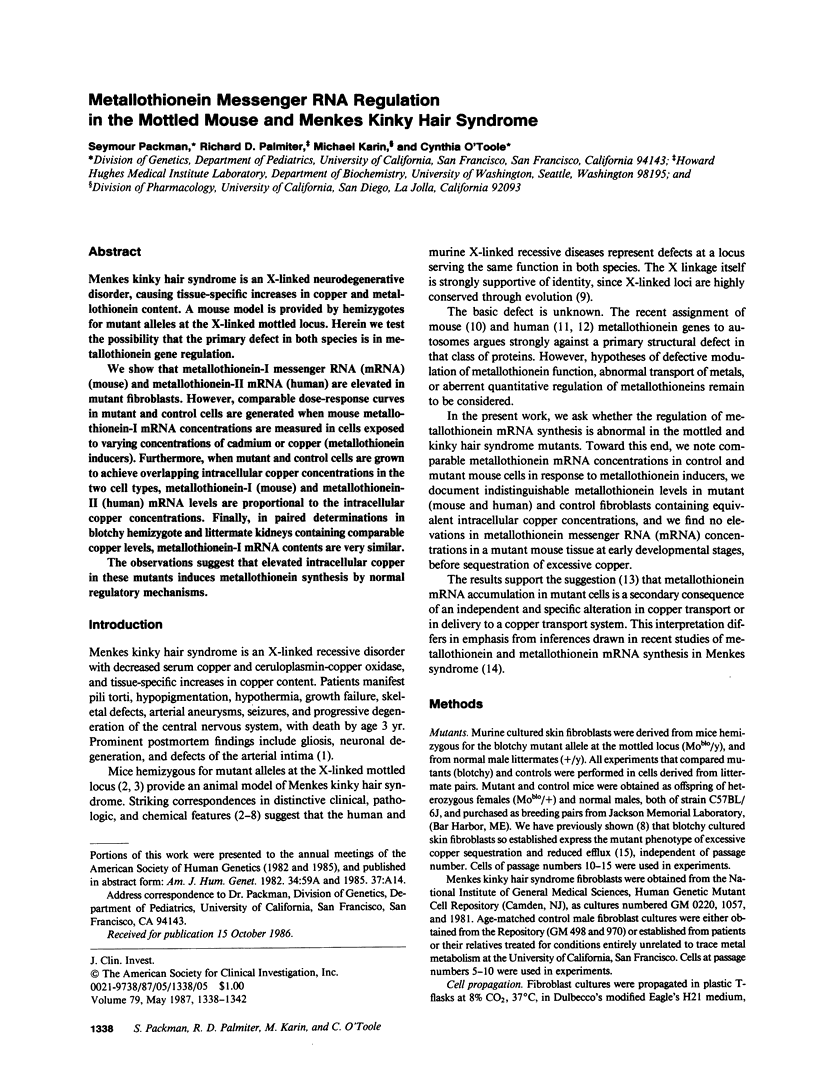
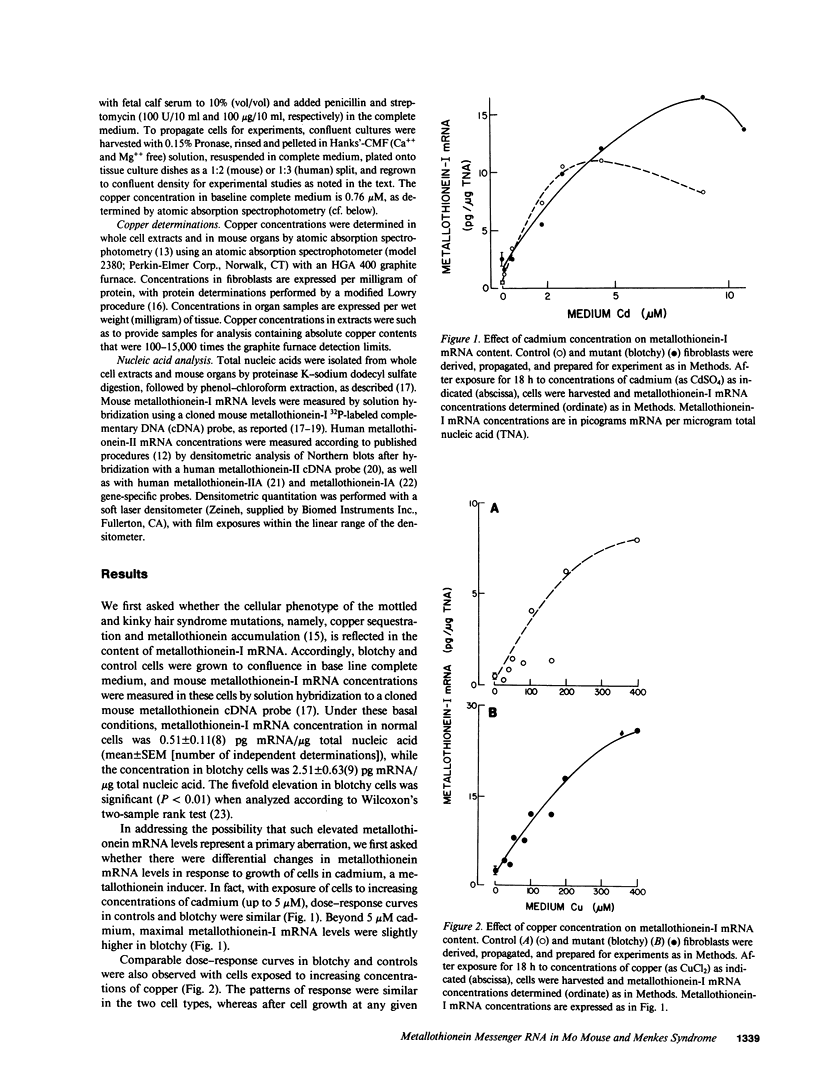
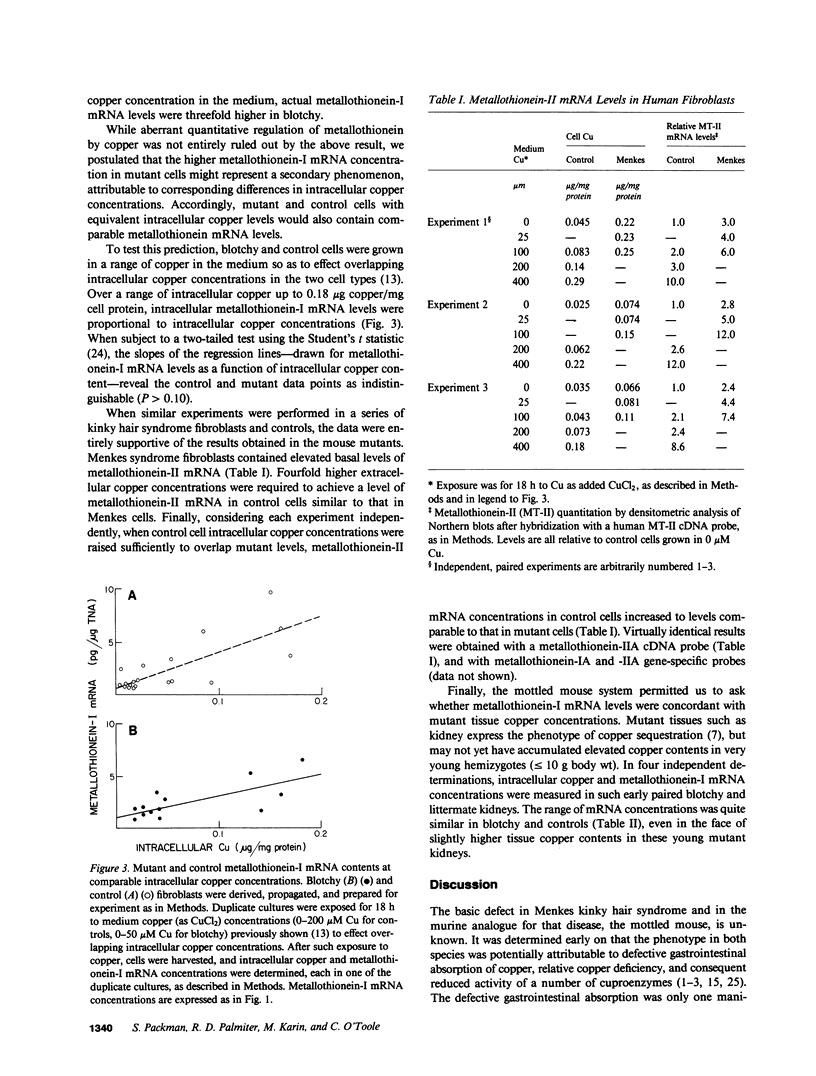
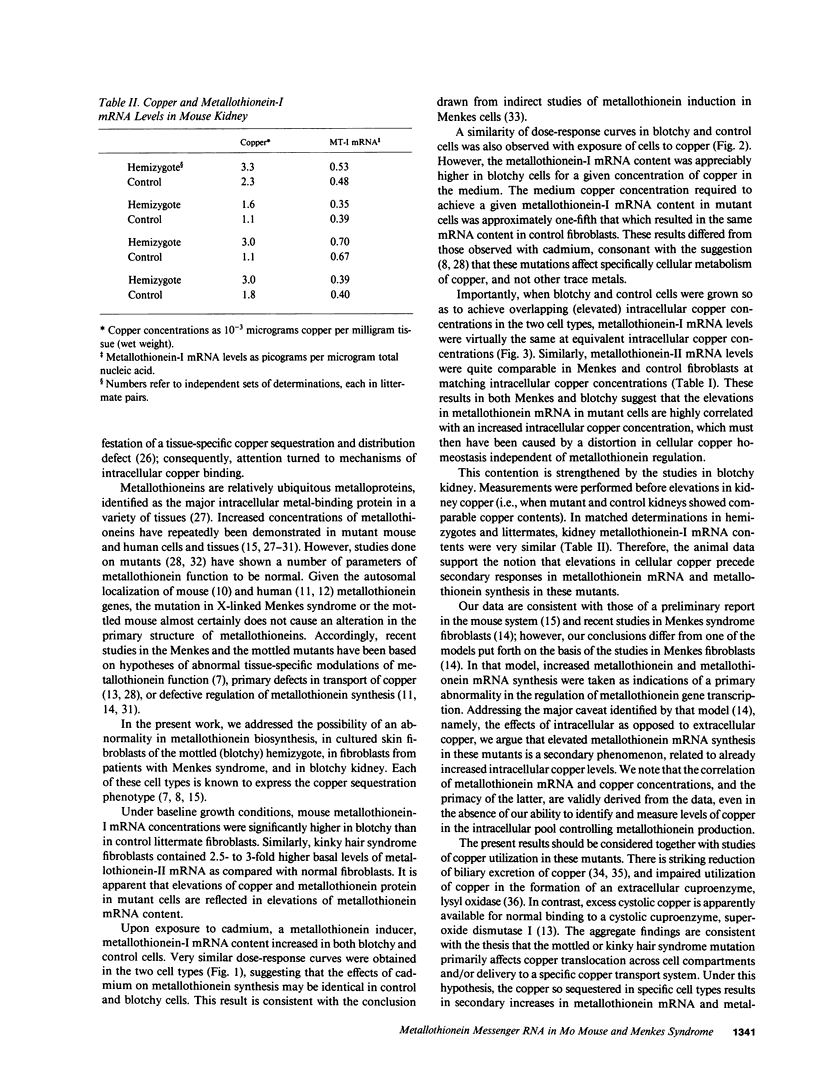
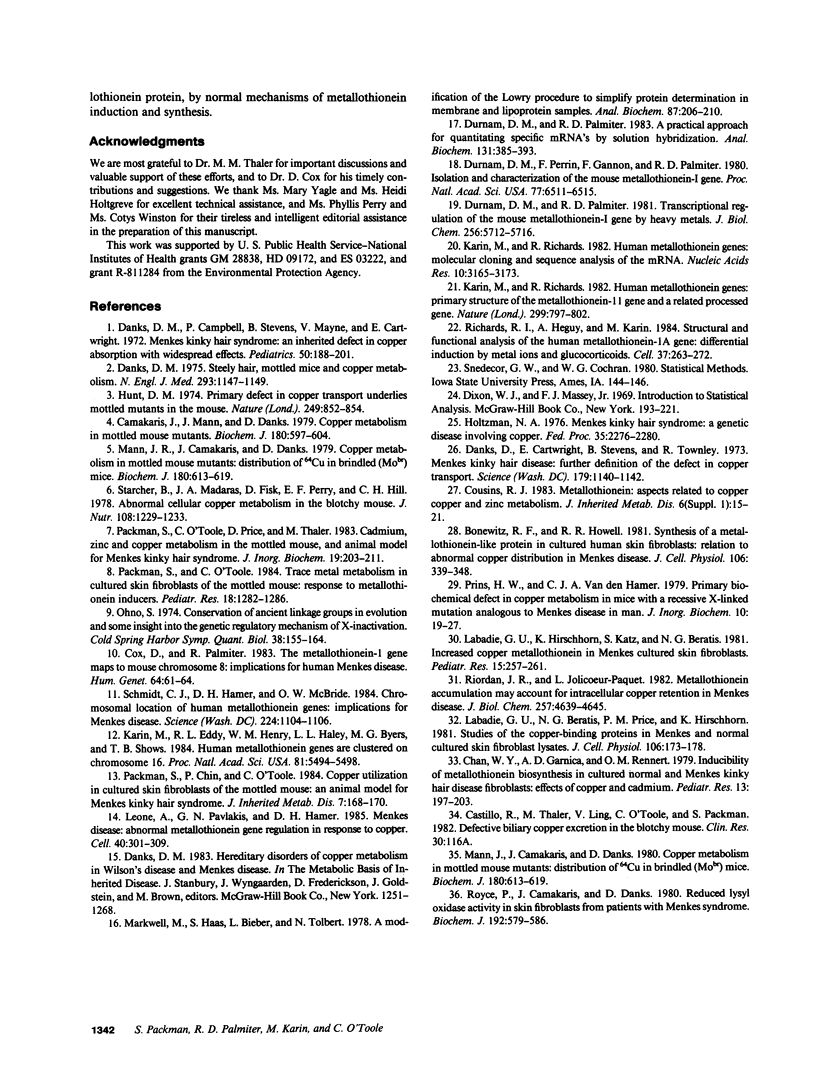
Selected References
These references are in PubMed. This may not be the complete list of references from this article.
- Bonewitz R. F., Jr, Howell R. R. Synthesis of a metallothionein-like protein in cultured human skin fibroblasts: relation to abnormal copper distribution in Menkes' disease. J Cell Physiol. 1981 Mar;106(3):339–348. doi: 10.1002/jcp.1041060303. [DOI] [PubMed] [Google Scholar]
- Camakaris J., Mann J. R., Danks D. M. Copper metabolism in mottled mouse mutants: copper concentrations in tissues during development. Biochem J. 1979 Jun 15;180(3):597–604. doi: 10.1042/bj1800597. [DOI] [PMC free article] [PubMed] [Google Scholar]
- Chan W. Y., Garnica A. D., Rennert O. M. Inducibility of metallothionein biosynthesis in cultured normal and Menkes kinky hair disease fibroblasts: effects of copper and cadmium. Pediatr Res. 1979 Mar;13(3):197–203. doi: 10.1203/00006450-197903000-00014. [DOI] [PubMed] [Google Scholar]
- Cousins R. J. Metallothionein--aspects related to copper and zinc metabolism. J Inherit Metab Dis. 1983;6 (Suppl 1):15–21. doi: 10.1007/BF01811318. [DOI] [PubMed] [Google Scholar]
- Cox D. R., Palmiter R. D. The metallothionein-I gene maps to mouse chromosome 8: implications for human Menkes' disease. Hum Genet. 1983;64(1):61–64. doi: 10.1007/BF00289481. [DOI] [PubMed] [Google Scholar]
- Danks D. M., Campbell P. E., Stevens B. J., Mayne V., Cartwright E. Menkes's kinky hair syndrome. An inherited defect in copper absorption with widespread effects. Pediatrics. 1972 Aug;50(2):188–201. [PubMed] [Google Scholar]
- Danks D. M., Cartwright E., Stevens B. J., Townley R. R. Menkes' kinky hair disease: further definition of the defect in copper transport. Science. 1973 Mar 16;179(4078):1140–1142. doi: 10.1126/science.179.4078.1140. [DOI] [PubMed] [Google Scholar]
- Danks D. M. Editorial: Steely hair, mottled mice and copper metabolism. N Engl J Med. 1975 Nov 27;293(22):1147–1149. doi: 10.1056/NEJM197511272932212. [DOI] [PubMed] [Google Scholar]
- Durnam D. M., Palmiter R. D. A practical approach for quantitating specific mRNAs by solution hybridization. Anal Biochem. 1983 Jun;131(2):385–393. doi: 10.1016/0003-2697(83)90188-4. [DOI] [PubMed] [Google Scholar]
- Durnam D. M., Palmiter R. D. Transcriptional regulation of the mouse metallothionein-I gene by heavy metals. J Biol Chem. 1981 Jun 10;256(11):5712–5716. [PubMed] [Google Scholar]
- Durnam D. M., Perrin F., Gannon F., Palmiter R. D. Isolation and characterization of the mouse metallothionein-I gene. Proc Natl Acad Sci U S A. 1980 Nov;77(11):6511–6515. doi: 10.1073/pnas.77.11.6511. [DOI] [PMC free article] [PubMed] [Google Scholar]
- Holtzman N. A. Menkes' kinky hair syndrome: a genetic disease involving copper. Fed Proc. 1976 Sep;35(11):2276–2280. [PubMed] [Google Scholar]
- Hunt D. M. Primary defect in copper transport underlies mottled mutants in the mouse. Nature. 1974 Jun 28;249(460):852–854. doi: 10.1038/249852a0. [DOI] [PubMed] [Google Scholar]
- Karin M., Eddy R. L., Henry W. M., Haley L. L., Byers M. G., Shows T. B. Human metallothionein genes are clustered on chromosome 16. Proc Natl Acad Sci U S A. 1984 Sep;81(17):5494–5498. doi: 10.1073/pnas.81.17.5494. [DOI] [PMC free article] [PubMed] [Google Scholar]
- Karin M., Richards R. I. Human metallothionein genes--primary structure of the metallothionein-II gene and a related processed gene. Nature. 1982 Oct 28;299(5886):797–802. doi: 10.1038/299797a0. [DOI] [PubMed] [Google Scholar]
- Karin M., Richards R. I. Human metallothionein genes: molecular cloning and sequence analysis of the mRNA. Nucleic Acids Res. 1982 May 25;10(10):3165–3173. doi: 10.1093/nar/10.10.3165. [DOI] [PMC free article] [PubMed] [Google Scholar]
- LaBadie G. U., Beratis N. G., Price P. M., Hirschhorn K. Studies of the copper-binding proteins in Menkes and normal cultured skin fibroblast lysates. J Cell Physiol. 1981 Feb;106(2):173–178. doi: 10.1002/jcp.1041060202. [DOI] [PubMed] [Google Scholar]
- Labadie G. U., Hirschhorn K., Katz S., Beratis N. G. Increased copper metallothionein in Menkes cultured skin fibroblasts. Pediatr Res. 1981 Mar;15(3):257–261. doi: 10.1203/00006450-198103000-00012. [DOI] [PubMed] [Google Scholar]
- Leone A., Pavlakis G. N., Hamer D. H. Menkes' disease: abnormal metallothionein gene regulation in response to copper. Cell. 1985 Feb;40(2):301–309. doi: 10.1016/0092-8674(85)90144-8. [DOI] [PubMed] [Google Scholar]
- Mann J. R., Camakaris J., Danks D. M. Copper metabolism in mottled mouse mutants: distribution of 64Cu in brindled (Mobr) mice. Biochem J. 1979 Jun 15;180(3):613–619. doi: 10.1042/bj1800613. [DOI] [PMC free article] [PubMed] [Google Scholar]
- Mann J. R., Camakaris J., Danks D. M. Copper metabolism in mottled mouse mutants: distribution of 64Cu in brindled (Mobr) mice. Biochem J. 1979 Jun 15;180(3):613–619. doi: 10.1042/bj1800613. [DOI] [PMC free article] [PubMed] [Google Scholar]
- Markwell M. A., Haas S. M., Bieber L. L., Tolbert N. E. A modification of the Lowry procedure to simplify protein determination in membrane and lipoprotein samples. Anal Biochem. 1978 Jun 15;87(1):206–210. doi: 10.1016/0003-2697(78)90586-9. [DOI] [PubMed] [Google Scholar]
- Ono S. Conservation of ancient linkage groups in evolution and some insight into the genetic regulatory mechanism of x-inactivation. Cold Spring Harb Symp Quant Biol. 1974;38:155–164. doi: 10.1101/sqb.1974.038.01.019. [DOI] [PubMed] [Google Scholar]
- Packman S., Chin P., O'Toole C. Copper utilization in cultured skin fibroblasts of the mottled mouse, an animal model for Menkes' kinky hair syndrome. J Inherit Metab Dis. 1984;7(4):168–170. doi: 10.1007/BF01805602. [DOI] [PubMed] [Google Scholar]
- Packman S., O'Toole C., Price D. C., Thaler M. M. Cadmium, zinc, and copper metabolism in the mottled mouse, an animal model for Menkes' kinky hair syndrome. J Inorg Biochem. 1983 Nov;19(3):203–211. doi: 10.1016/0162-0134(83)85025-9. [DOI] [PubMed] [Google Scholar]
- Packman S., O'Toole C. Trace metal metabolism in cultured skin fibroblasts of the mottled mouse: response to metallothionein inducers. Pediatr Res. 1984 Dec;18(12):1282–1286. doi: 10.1203/00006450-198412000-00011. [DOI] [PubMed] [Google Scholar]
- Prins H. W., Van den Hamer C. J. Primary biochemical defect in copper metabolism in mice with a recessive X-linked mutation analogous to Menkes' disease in man. J Inorg Biochem. 1979 Feb;10(1):19–27. doi: 10.1016/s0162-0134(00)81002-8. [DOI] [PubMed] [Google Scholar]
- Richards R. I., Heguy A., Karin M. Structural and functional analysis of the human metallothionein-IA gene: differential induction by metal ions and glucocorticoids. Cell. 1984 May;37(1):263–272. doi: 10.1016/0092-8674(84)90322-2. [DOI] [PubMed] [Google Scholar]
- Riordan J. R., Jolicoeur-Paquet L. Metallothionein accumulation may account for intracellular copper retention in Menkes' disease. J Biol Chem. 1982 Apr 25;257(8):4639–4645. [PubMed] [Google Scholar]
- Royce P. M., Camakaris J., Danks D. M. Reduced lysyl oxidase activity in skin fibroblasts from patients with Menkes' syndrome. Biochem J. 1980 Nov 15;192(2):579–586. doi: 10.1042/bj1920579. [DOI] [PMC free article] [PubMed] [Google Scholar]
- Schmidt C. J., Hamer D. H., McBride O. W. Chromosomal location of human metallothionein genes: implications for Menkes' disease. Science. 1984 Jun 8;224(4653):1104–1106. doi: 10.1126/science.6719135. [DOI] [PubMed] [Google Scholar]
- Starcher B., Madaras J. A., Fisk D., Perry E. F., Hill C. H. Abnormal cellular copper metabolism in the blotchy mouse. J Nutr. 1978 Aug;108(8):1229–1233. doi: 10.1093/jn/108.8.1229. [DOI] [PubMed] [Google Scholar]


